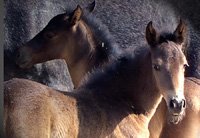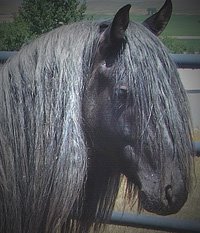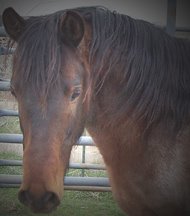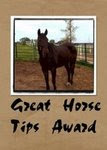What to do? I could throw up my hands, declare that going bitless won't work for Aaruba after all, and slap a tom thumb bit in his mouth instead. I guarantee that would slow him down...for a while...until he figured out how to evade it. Knowing Aaruba, he'd probably take the head-tossing route, and I'd have an even bigger problem on my hands.
No, this tendency to rush home isn't an equipment problem. It's a training problem. Furthermore, it's not Aaruba's problem, but mine. As Robert Painter told me many times, "If there's a problem with the horse, look to the trainer."
I'm usually pretty sensitive to brewing trouble, able to predict and short-circuit a training issue before it really develops. So how did this one get by me? I think a lot of it has to do with the nature of endurance conditioning. When Aaruba and I hit the road, I know how far we need to go and how fast we ought to cover the miles. We won't make 8 miles in an hour if we walk the return journey. So we trot both ways, maybe canter a little to push his aerobic limits.
There's nothing wrong with that, in and of itself, but when timing becomes more important than training...well, look what I got: a young and excitable horse that's fit enough to blast home in less time than it takes to let fly a string of curses.
Yesterday, I decided to solve the problem. Aaruba and I headed out for a ride at our usual trot. When it came time to head home, however, I asked him to walk. As expected, he slipped into an impatient jig. I immediately took hold of the right rein, pulled his nose around to my toe, and anchored the rein behind my hip. He circled six or eight times before stopping. The moment he stopped, I released all pressure on the rein and petted his neck.
We tried walking again. He broke into a trot, and I pulled him around in more tight, uncomfortable circles, this time to the left. As before, I released the rein only when he finally decided to stop. After one more encore, Aaruba decided that trotting when I'd asked for a walk was way more trouble than it was worth.
That lesson accomplished, I proceeded to ask Aaruba for a trot -- just a few steps, then back to a walk. He responded, but tried to trot again and was rewarded with more circling. I noticed that he stopped much sooner this time.
Walk, trot, walk, trot again, walk again, trot longer, walk shorter, trot some more. Every time Aaruba resisted my request to walk, broke gait, or trotted faster than I asked, we circled. I never lost my temper, yanked a rein, slapped a shoulder, or bruised a rib with my heel. The circling was not intended as punishment for misbehavior, but rather as a means of making disobedience more work than obedience.
Success! Within twenty minutes we'd settled into a medium trot on a loose rein, headed home in a civilized manner. I imagine a few reminders will be in order during our next several rides, and you'll likely see slower times in Aaruba's training log. The training benefit will be worth every second.
Another of Robert Painter's favorite lines surfaced in my mind as Aaruba and I trotted peaceably up the last hill toward home. "Never forget: You aren't training the horse's body. You're training his mind."
Never a truer word, friends. Never a truer word.










1 comment:
Bravo!
Well done!
Thanks for sharing this.
sj
Post a Comment